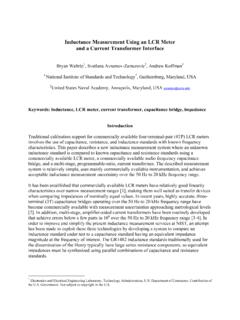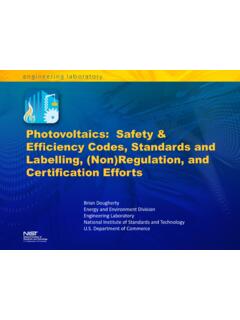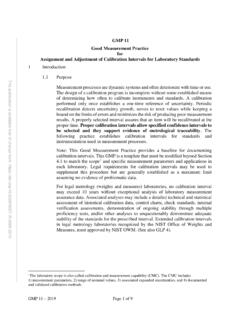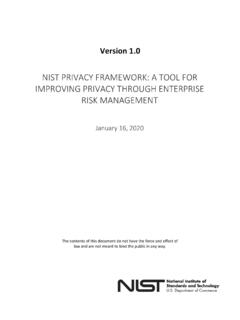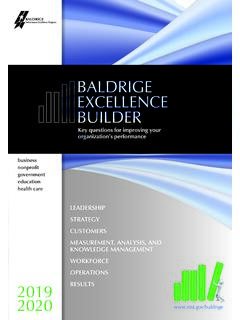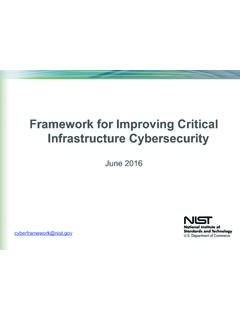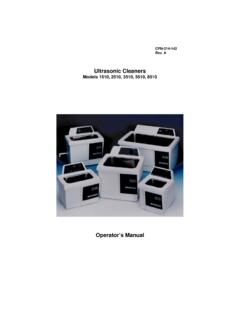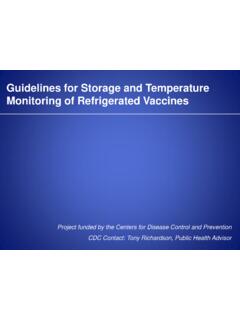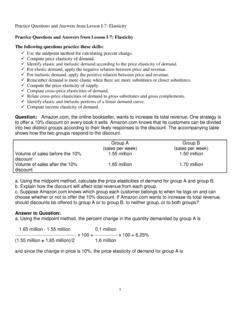Transcription of Evaluation of Cloud Computing Services Based on NIST 800 ...
1 Special Publication 500-322 Draft - 20170427 DRAFT - Evaluation of Cloud Computing Services Based on NIST 800-145 National Institute of Standards and Technology (NIST) Eric Simmon Based on work done by the NIST Cloud Computing Services Public Working Group Evaluation of Cloud Computing Services Based on NIST 800-145 1 This document provides clarification for qualifying a given Computing capability as a Cloud service by determining if it aligns with the NIST definition of Cloud Computing ; and for categorizing a Cloud service according to the most appropriate service model (SaaS, PaaS, or IaaS). Acknowledgements NIST thanks the many experts in industry and government who contributed their thoughts to the creation and review of this definition. NIST would like to acknowledgement the members of the NIST Cloud Computing Services Public Working Group listed below who worked many hours providing input for this document.
2 A special thanks to Cary Landis who was the industry chair of the group. Cary Landis (Chair NIST Cloud Computing Services Public Working Group) Ali Khalvati (GSA) Lalit Bajaj (GSA) Don Beaver (GSA) James Yaple Angela Rowe James Mooney James Fowler Eugene Luster Larry Lamers Keith Parker (ASI for GSA) Gary Rouse (VMSI for GSA) Travis Ferguson Chris Ferris Kavya Pearlman Evaluation of Cloud Computing Services Based on NIST 800-145 2 Contents 1 Introduction .. 3 2 The NIST Definition of Cloud Computing .. 4 3 Analysis of the Essential Characteristics of Cloud Computing .. 6 On- demand self-service .. 6 Broad network access .. 7 Resource Pooling .. 8 Rapid elasticity .. 9 Measured service .. 9 4 Analysis of Cloud Service Models .. 10 Software as a Service (SaaS) .. 11 Platform as a Service (PaaS) .. 12 Infrastructure as a Service (IaaS) .. 13 5 Analysis of Cloud Deployment Models.
3 14 Private Cloud Computing Service Deployment .. 17 Community Cloud Computing Service Deployment .. 18 Public Cloud Computing Service Deployment .. 19 Hybrid Cloud Computing Service Deployment .. 19 6 Worksheets .. 20 Cloud Service Worksheet .. 20 Cloud Service Model Worksheet .. 21 Cloud Deployment Model Worksheet .. 22 7 Example Cloud Service Marketing Terms .. 22 8 References .. Error! Bookmark not defined. Evaluation of Cloud Computing Services Based on NIST 800-145 3 1 Introduction The Federal Cloud Computing Strategy1 characterizes Cloud Computing as a profound economic and technical shift (with) great potential to reduce the cost of federal Information Technology (IT) systems while .. improving IT capabilities and stimulating innovation in IT solutions. To promote the mission and economic benefits of Cloud Services , the Office of Management and Budget (OMB) issued a Cloud First policy to encourage the adoption of Cloud Computing Services to gain new efficiencies and save money.
4 The policy requires agency Chief Information Officers (CIOs) to implement a Cloud - Based service whenever there is a secure, reliable, and cost-effective option. The policy takes advantage of cost savings efficiencies that were described in several complementary and parallel United States Government (USG) initiatives, such as the 25 Point Implementation Plan to Reform Federal Information Technology Management. The National Institute of Standards and Technology (NIST), consistent with its mission,2 has a technology leadership role in support of the USG secure and effective adoption of the Cloud Computing model3 to reduce costs and improve Services . NIST was charged with the mission of developing a Cloud Computing technology roadmap and to lead efforts in developing and prioritizing Cloud Computing standards. The NIST Cloud Computing Program (NCCP) created a series of public working groups on Cloud Computing to generate input for the SP 500-291 NIST Cloud Computing Standards and Roadmap, and SP 500-293 NIST Cloud Computing Technology Roadmap, Volume I and II.
5 This document, hereafter referred to as the Roadmap, contains ten high-level priority requirements in security, interoperability, and portability for the USG s adoption of Cloud Computing . Requirement 4 of the Roadmap is for Clearly and consistently categorized Cloud Services . This requirement is important to ensure that customers understand the characteristics of different types of Cloud Services and are able to objectively evaluate, compare, and select Cloud Services suitable to meet their business objectives. In the absence of clarification, organizations are at risk of adopting Services that do not provide characteristics of Cloud Computing . For example, some vendors reportedly decide to label their Computing offerings as Cloud Services , even if the offerings do not support the essential characteristics of a Cloud service in the NIST definition. Furthermore, the frequent and common usage of the informal aaS suffix in marketing, as in EaaS , DaaS , and STaaS (often refered to as XaaS or Everything as a Service ) is confusing, and (unintentionally) obfuscating the architecturally well-founded distinction of IaaS, PaaS, and SaaS.
6 These Cloud service types are generally coined by appending the suffix aaS after a type of Computing capability. This makes it difficult to determine whether something is a Cloud service and has unintended consequence for organizations trying to satisfy their Cloud -first objectives. To demystify the ambiguity surrounding Cloud Services , the NIST Cloud Computing Services Public Working Group analyzed the NIST Cloud Computing definition and developed guidance on how to use it to evaluate Cloud Services . 1 Office of Management and Budget, Chief Information Officer, Federal Cloud Computing Strategy, Feb. 8, 2011. Online: 2 This effort is consistent with the NIST role per the National Technology Transfer and Advancement Act (NTTAA) of 1995, which became law in March 1996. 3 NIST Definition of Cloud Computing , Special Publication 800-145, September 2011. Evaluation of Cloud Computing Services Based on NIST 800-145 4 This document clarifies the Cloud Computing service models as published in NIST Special Publication (SP) 800-145, The NIST Definition of Cloud Computing (NIST Definition, September 2011).
7 The NIST Definition was intended for the stated purpose of broad comparisons of Cloud Services and deployment strategies, and to provide a baseline for discussion from what is Cloud Computing to how to best use Cloud Computing . 4 The clarification supports the proper planning for Cloud migration, deployment, and retirement of relevant legacy systems. The GAO recommended in July 2012 that seven audited federal agencies should establish estimated costs, performance goals, and plans to retire associated legacy systems for each type of Cloud - Based service as well as the same for retiring legacy systems, as applicable, for planned additional Cloud - Based services5. As this document is meant to provide guidance in understanding the categorization, Evaluation , comparison, and selection of Cloud Services , it does not provide a prescriptive set of guidelines for the selection process. Instead, it uses the principles set forth in the NIST Cloud Computing definition as a framework for understanding a ccustomer s requirements in a Cloud Computing context and the capabilities offered by Cloud service providers (CSP)s to enable easier decision making.
8 The NIST Cloud Computing definition allows for flexibility in its interpretation and in many cases, the final decision relies on a mixture of objective and subjective perspectives. This document is intended for use by any stakeholder, including, but not limited to, buyers of IT and Cloud Services , IT managers, program managers, FedRAMP stakeholders, systems integrators, resellers of Cloud Services , etc. 2 The NIST Definition of Cloud Computing NIST SP 800-145 was published in the fall of 2010. Since that time, the Cloud Computing environment has experienced a growth in technical maturity, yet the NIST Definition has retained a worldwide acceptance. This document provides an analysis of the NIST Definition of Cloud Computing Based on today s perspective and provides a methodology for evaluating Services , complementing the NIST definition. NIST SP 800-145 provides a one sentence definition of Cloud Computing as a model for enabling ubiquitous, convenient, on- demand network access to a shared pool of configurable Computing resources ( , networks, servers, storage, applications, and Services ) that can be rapidly provisioned and released with minimal management effort or service provider interaction.
9 In addition, the NIST definition introduces the supporting concepts of three Cloud service models, five essential characteristics, and four types of Cloud deployments. In total, the NIST Cloud Computing Definition is composed of 14 interrelated terms and their associated definitions: Core definition of the Cloud Computing model (above) Five essential characteristics o On- demand self-service o Broad network access o Resource pooling o Rapid elasticity o Measured service 4 5 Evaluation of Cloud Computing Services Based on NIST 800-145 5 Three service models o Software as a Service (SaaS) o Platform as a Service (PaaS) o Infrastructure as a Service (IaaS) Four deployment models o Public o Private o Community o Hybrid Footnoted definition of Cloud infrastructure. SP500-145 also includes multiple clarifying statements that are integrated into the text of the various definitions. The NIST Definition makes use of additional terms that are clarified below: Application: Within the context of Cloud Computing , the term application may refer to either a Cloud -enabled SaaS, web or mobile application ( Facebook), or an application that exists on a virtual machine ( , Linux application).
10 It is therefore preferable to clarify that type of application when using the term to avoid confusion. as a Service (aaS): The term as a [ Cloud ] Service is a suffix describing a Computing capability that supports all five essential characteristics of Cloud Computing . The term as a service (aaS) implies that SaaS, PaaS, and IaaS are delivered by way of software. Cloud Infrastructure: The collection of hardware and software that enables the five essential characteristics of Cloud Computing . The consumer of a Cloud service does not manage or control the underlying Cloud infrastructure. Cloud Infrastructure is represented in SP 500-292 NIST Cloud Computing Reference Architecture (CCRA) within the Resource Abstraction and Control layer and Hardware layer. Cloud Service: A Computing capability that is delivered as a service. Essential Characteristics: The five characteristics that must be available in a Computing capability to be qualified as a Cloud service.
